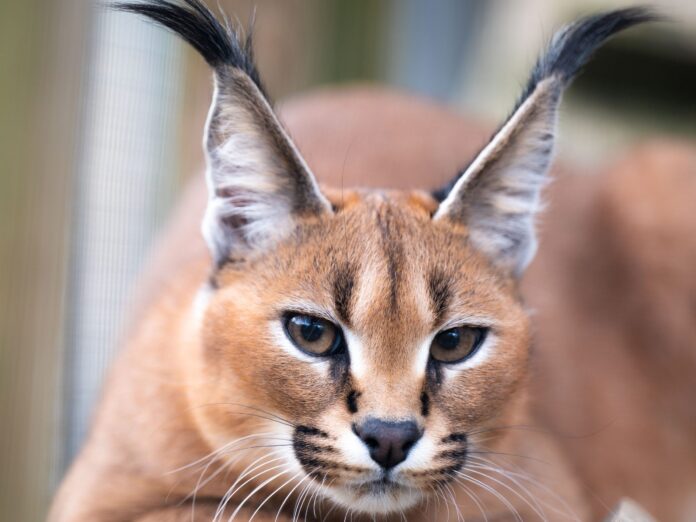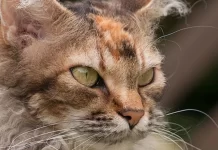Last Updated on November 15, 2023 by Fumipets
Do Caracals Make Great Pets? Here’s What You Need to Know!
The question of whether caracals make great pets requires careful consideration, balancing the appeal of these exotic wild cats with the responsibilities and challenges of keeping them in a domestic setting. Caracals, with their captivating appearance and unique characteristics, may attract enthusiasts, but potential owners must weigh the practicalities and ethical considerations involved in caring for these creatures.
Do Caracals Make Great Pets?
The caracal is a huge wild cat that is native to Africa, the Middle East, Central Asia, and desert portions of northern India and Pakistan. It has a highly unusual appearance. This cat has long legs, a long tufted black ear, a short reddish-gold coat, and a slim, streamlined body. The Turkish term “karakulak,” which means “black ear,” is the source of the cat’s name.
Caracals are a species that many people are unfamiliar with, yet some people do keep them as pets. In certain jurisdictions, keeping a caracal as a pet is prohibited, but it is permitted in others. Because of this, you should make sure you can keep one of these cats as a pet by checking with your state regulations before purchasing one.
Disclaimer
We oppose the practice of keeping wild cats as pets in order to be impartial and fair. It is advisable to leave the upkeep and maintenance of these gorgeous creatures to specialists and experts with enough resources. Therefore, for certain individuals who can properly house, feed, and care for these enormous cats, caracals may make excellent pets.
Here is a collection of information regarding caracals you should be aware of if you’re thinking about getting one as a pet.
1. It Looks a Lot Like a Serval
With its tiny, round head and large eyes, a caracal resembles an ordinary house cat, but its appearance is more serval-like. In spite of the fact that the serval has spots and the caracal does not, many people confuse these two wild cats.
Both servals and caracals are medium-sized wild cats, however servals prefer wetter habitats versus caracals’ preference for desert areas.
2. It’s an Impressively Powerful Cat
A caracal may grow to be 3 feet long and as heavy as 40 pounds. Both sexes are strong and quick, however the male is usually heavier than the female. The size of this wild cat is sufficient for self-care and defense, but it isn’t nearly powerful enough to compete with apex predators like tigers and lions.
A caracal’s high-jumping ability allows it to capture birds out of the sky. Because of their excellent agility, these cats can readily scale trees to grab food, much as leopards can.

3. Their Long Ears Are Very Sensitive to Sound
The caracal cat’s large, sharp ears are always attentive. The cat’s prickly ears, which are controlled by around 20 muscles, enable it to hear even the smallest noises.
Caracals must depend on their exceptional hearing to thrive in the wild. By directing noises into the ears, the lengthy tufts at the cat’s ear tips improve hearing.
4. They’re Meat-Eaters
An omnivore that chases its prey, the caracal. The meat-eating caracal survives in the wild by eating tiny rodents, birds, and rabbits and sometimes gorges on larger prey like gazelles or small antelope. This species avoids bigger creatures that may hurt it since it is aware that it cannot stand a chance against a strong zebra, leopard, or lion.
5. It’s a Solitary Animal in the Wild
Caracals often live in couples during the mating season for obvious reasons. But this cat hunts by itself most of the time and lives alone. A caracal’s excellent climbing abilities allows it to ambush victims covertly and rapidly. These cats are skilled diggers who will dig out moles, mice, and shrews from the ground.

6. They Can Be Dangerous
A caracal can outrun an ostrich and a small antelope due to its speed. These aggressive, nocturnal cats are not to be trifled with. It won’t think twice to confront you if you chance to come across one in the wild. When threatened, a caracal will strike without thinking.
7. They Rarely Attack Humans
Despite the possibility of a caracal attacking a person if it is trapped and feels threatened, these cats don’t often do so. These cats would much sooner flee from an apparent threat than risking their health or perhaps their lives in an altercation.
Some individuals believe that since caracal assaults are rare, these animals may be readily domesticated and cared for like house cats. Others think that since caracals are wild creatures, it’s preferable to leave them in the wild where they belong.
8. It’s Not Cheap to Care for a Caracal
Even while caracal kittens are adorable and cuddly, they grow up rapidly to become large, strong cats. This animal has to be caged or kept in a very sturdy enclosure since it cannot be let wander free 24 hours a day inside a house.
A decent cage might cost well over $2,000 on average. The price of a caracal cat might reach several thousand dollars a year when you include the expense of a caracal’s housing, food, vaccines, and transport cage.

9. They Can Make Good Pets for Certain People
For those who are knowledgeable about the requirements of this extraordinary cat species, caracals may make excellent pets. A caracal is not a good pet for someone who is inexperienced or just wants a huge cat to impress their friends.
It may be highly hazardous to have a caracal as a pet if it is not properly taught and cared for. A caracal requires care seven days a week, thus keeping one as a pet requires a significant amount of sacrifice. This implies that because a caracal requires a huge cage, vacations may need to be forgone along with living space.
As it learns to live in captivity in a small area, a pet caracal must also make certain sacrifices. Additionally, it must survive without its claws, which it uses to grab and kill its prey in the wild.
Conclusion
If you reside in a state where keeping a caracal as a pet is permitted and you believe that you are competent and financially able to do so, you may surely do so. Just keep in mind that you must be prepared to devote a lot of time, money, and effort to care for a large cat that prefers to live in its natural environment.
FAQs About Keeping Caracals as Pets:
1. What Makes Caracals Attractive as Pets?
Caracals are known for their striking appearance, resembling miniature wildcats, and can form strong bonds with their owners. Their playful and affectionate behaviors may be appealing to those seeking a unique feline companion.
2. What Challenges Come with Owning a Caracal?
Despite their charm, caracals pose challenges as pets due to their wild instincts. They have specific dietary and environmental requirements, and their unpredictable behavior may be unsuitable for domestic living. Understanding these challenges is crucial for responsible ownership.
3. Do Caracals Have Specialized Care Needs?
Yes, caracals require specialized care. Owners must be well-versed in their natural behaviors, nutritional needs, and the legalities surrounding exotic pet ownership. Providing an environment that mimics their natural habitat is essential for their well-being.
4. Are Caracals Legal to Keep as Pets Everywhere?
The legality of keeping caracals as pets varies by location. Many places have strict regulations or outright bans on owning exotic animals. Prospective owners must thoroughly research and comply with local laws to ensure they can legally keep a caracal.
5. What Should Potential Owners Consider Before Getting a Caracal?
Prospective owners should consider the long-term commitment required for caring for a caracal. Thorough education on their behaviors, social needs, and potential challenges is essential. Additionally, individuals must evaluate their ability to provide a safe and suitable environment for the caracal.


















